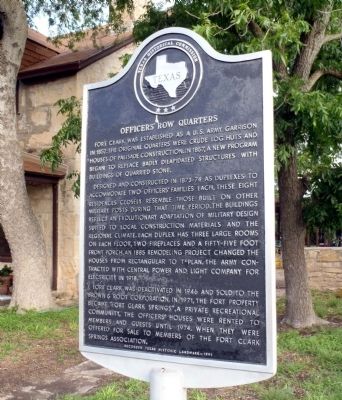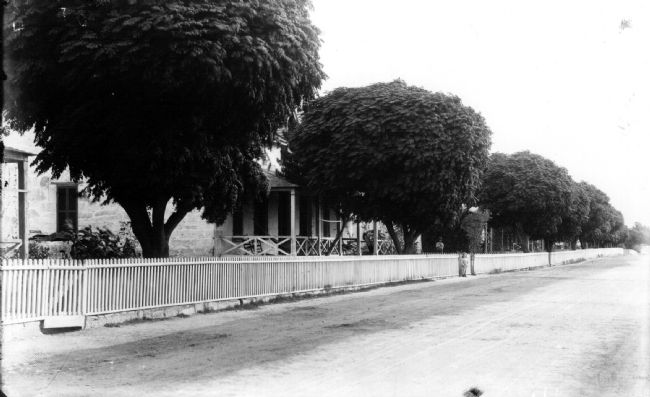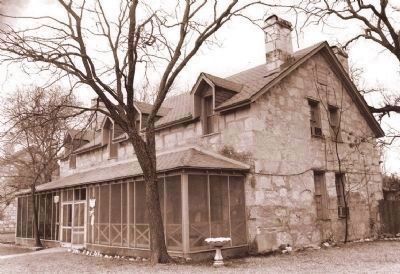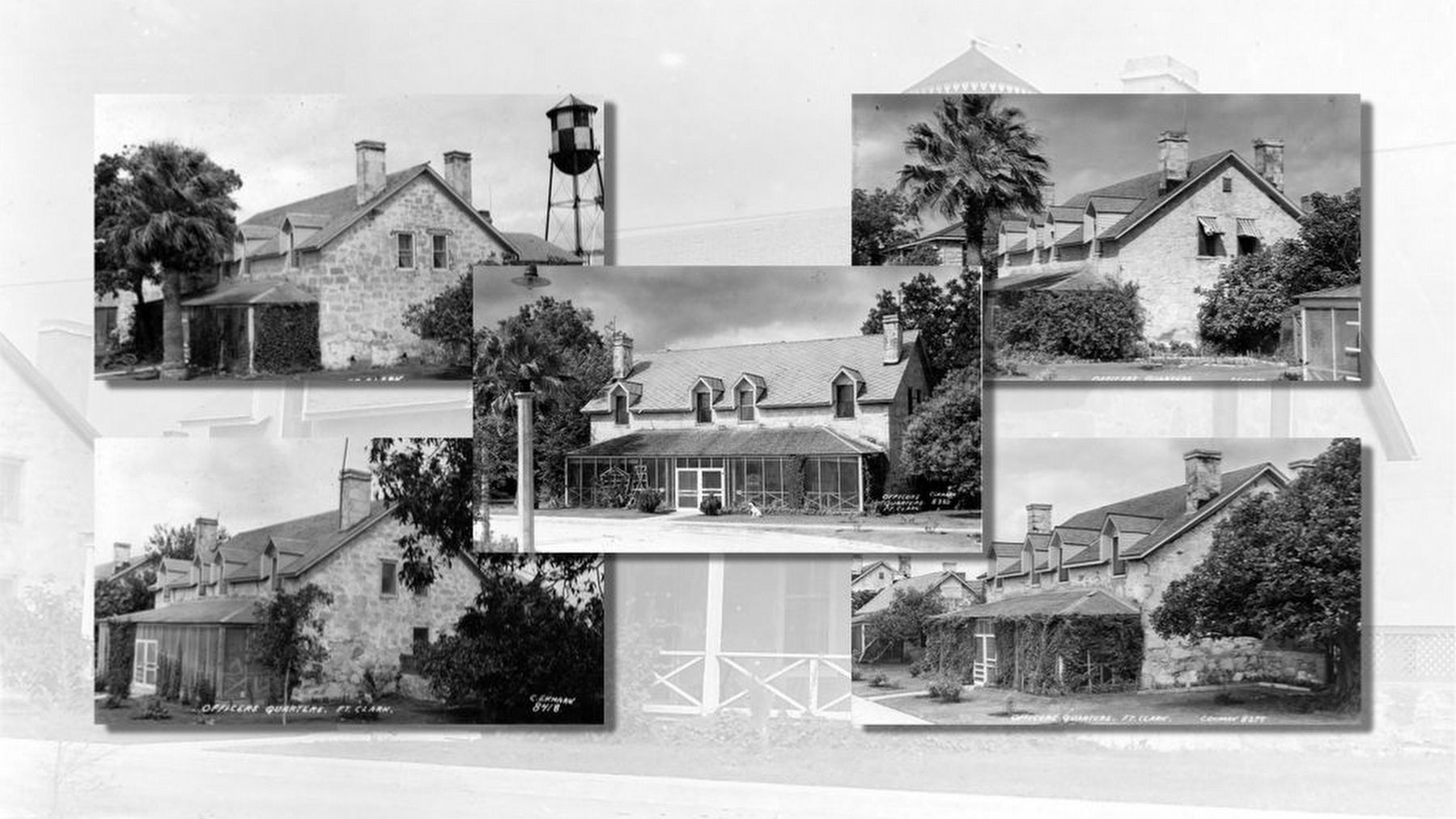Near Brackettville in Kinney County, Texas — The American South (West South Central)
Officers' Row Quarters
Designed and constructed in 1873-74 as duplexes to accommodate two officers' families each, these eight residences closely resemble those built on other military posts during that time period. The buildings reflect an evolutionary adaptation of military design suited to local construction materials and the regional climate. Each duplex has three large rooms on each floor, two fireplaces and a fifty-five foot front porch. An 1885 remodeling project changed the houses from rectangular to T-plan. The Army contracted with Central Power and Light Company for electricity in 1918.
Fort Clark was deactivated in 1946 and sold to the Brown and Root Corporation. In 1971, the fort property became “Fort Clark Springs”, a private recreational community. The officers' houses were rented to members and guests until 1974, when they were offered for sale to members of the Fort Clark Springs Association.
Erected 1991 by Texas Historical Commission. (Marker Number 3678.)
Topics. This historical marker is listed in this topic list: Notable Buildings. A significant historical year for this entry is 1852.
Location. 29° 18.358′ N, 100° 25.326′ W. Marker is near Brackettville, Texas, in Kinney County. Marker is on Colony Row south of Patton Drive, on the right when traveling south. Marker is located on Fort Clark Springs in the Fort National Register Historic District and is accessible to the public. All properties recognized by the marker are now private residences. Touch for map. Marker is in this post office area: Brackettville TX 78832, United States of America. Touch for directions.
Other nearby markers. At least 8 other markers are within walking distance of this marker. Married Officers' Quarters 8-9 (a few steps from this marker); Remolino Raid (within shouting distance of this marker); Officers Quarters 2-3 and 4 (within shouting distance of this marker); Fort Clark Post Theater (about 500 feet away, measured in a direct line); Adjutant's Quarters (Quarters #20) (about 600 feet away); 1873 Infantry Barracks (about 600 feet away); U.S. Army Unit Memorial (about 600 feet away); Seminole-Negro Indian Scout Detachment (about 600 feet away). Touch for a list and map of all markers in Brackettville.
More about this marker. The marker is placed at the first of eight sets of quarters and is the only RTHL marker in Texas which recognizes
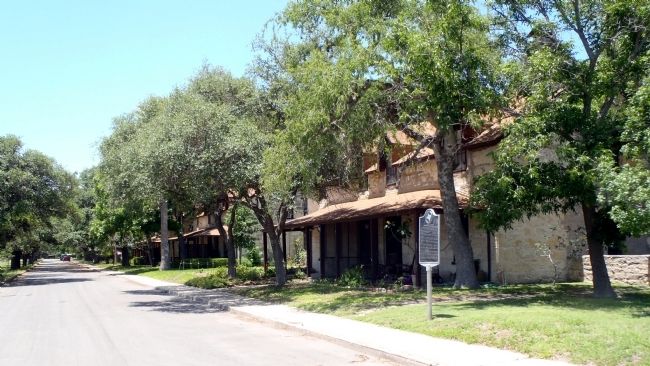
Photographed By William F Haenn, May 17, 2012
2. Fort Clark's Officers' Row Quarters, "The Line."
Eight sets of limestone duplex officers’ quarters were completed in 1873-74. The kitchens were raised one-story in 1886. Each set of quarters contains almost 3,000 square feet of living space. These buildings have changed little in 134 years. They are still enjoyed and cared for by their current residents. Somehow even now, footsteps echo from the countless Army families who made these houses their homes.
Regarding Officers' Row Quarters. Eight sets of quarters for company grade officers were built by the United States Army between 1873 and 1874, establishing Fort Clark’s Officers’ Row. The properties are included in Fort Clark’s National Register Historic District. These two-story story double sets of quarters are constructed of local limestone and form the line of company grade officer's quarters. Today, the sixteen properties continue to fulfill their original intended purpose of family housing. The presence of these buildings is tied undeniably to the proud history of Fort Clark.
The National Register narrative of the Fort Clark Historic District observes, “Although construction of the fort spanned a period of approximately sixty years, the structures comprising the main body of the complex are integrally related to one another and the parade ground, and appear as components of a whole rather than individuals. While designs vary, characteristics common to all contribute significantly to the cohesion of the group. Solidly massed in simple geometric configuration the one and two-story buildings are constructed of native limestone obtained from fort property. They are sturdily built for function and endurance with a minimum of applied decorative.”
In
the early 1870's Fort Clark rapidly expanded to accommodate and support the regimental size garrison needed to deal effectively with the increasing number of Indian depredations along the border. The post doubled in size from 1873 to 1875. The reports of Acting Assistant Surgeon, D. Jackson, and Assistant Surgeon, P. Middleton, United States Army, in "War Department, Surgeon-General's Office, Circular No. 8," dated May 1, 1875 are the first official record of the new officers' quarters, "Nine new buildings are now completed for officers' quarters; they are built of stone, two stories high, with porch in front, and back buildings." These quarters face the new parade ground and are aligned on an "L" shape axis with six sets on the long side of the "L," two sets on the short side, and then the Commanding Officer's Quarters. The Quartermaster "Plans and Specifications of Company Officers Quarters at Fort Clark Tx" dated 1873 includes the statement, "The above Estimate [$6,955.72] is for one building, ten are required." The ground was laid out for ten buildings; however, only eight were built, possibly due to funding con-straints.
Stone is the predominant construction material used within the Fort Clark Historic District and the Officers’ Row Quarters are a solid case in point. When these quarters were built stone was used in load bearing masonry walls and pier and beam foundations.
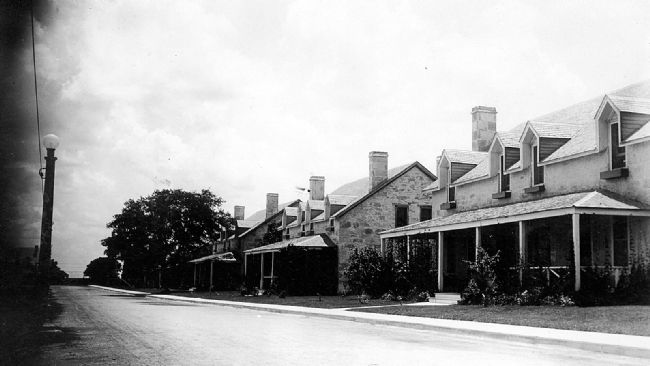
Courtesy Old Guardhouse Museum, circa 1920s
4. Early 20th century historic view of Fort Clark's Officers' Row Quarters
In the foreground is Quarters No. 12-13. Six sets of quarters for company grade officers [Captains and Lieutenants] make up what was commonly referred to as “the line.” Note the window flower boxes, light color paint [possibly the post color scheme recommended in 1928 of light gray, ivory cream and seal brown] and the decided absence of trees.
Fort Clark quietly and unceremoniously slipped into history and out of active service on August 28, 1944, when the last soldiers departed. The Corps of Engineers served as caretakers until the venerable post was declared surplus and sold for salvage to the Texas Railway Equipment Company in October of 1946. The new owners tore down the wood frame World War II buildings (nearly 1500). However, through considerable foresight, the historic 19th and early 20th century structures and stone buildings were spared the wrecking ball. The Brown Foundation operated the fort as a guest ranch until 1971 when the property was sold to a private developer who created a gated community and homeowners association, which operates today as the Fort Clark Springs Association.
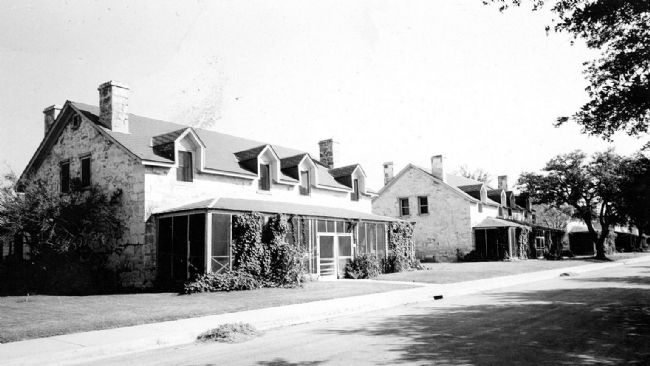
Photographed By Picture Postcard, circa 1950s
5. Historic view during the Guest Ranch era.
Officers’ quarters on “the line,” built in 1873-74, became short-term rental properties where guests could spend a weekend, a week, or a month. The street was renamed “Colony Row” and each set of quarters was named for a famous officer who once served at Fort Clark. Hand-me-down furnishings from the Driskill Hotel in Austin made for little individuality, but it was still a special treat to stay where army families once called home. In 1979 the quarters were sold to private owners.
Credits. This page was last revised on March 26, 2023. It was originally submitted on May 17, 2012, by William F Haenn of Fort Clark (Brackettville), Texas. This page has been viewed 830 times since then and 61 times this year. Photos: 1, 2, 3, 4, 5. submitted on May 17, 2012, by William F Haenn of Fort Clark (Brackettville), Texas. 6. submitted on November 12, 2013, by Wallace L. Morgan of Nixon, Texas. 7. submitted on March 25, 2023, by William F Haenn of Fort Clark (Brackettville), Texas. • Bernard Fisher was the editor who published this page.
